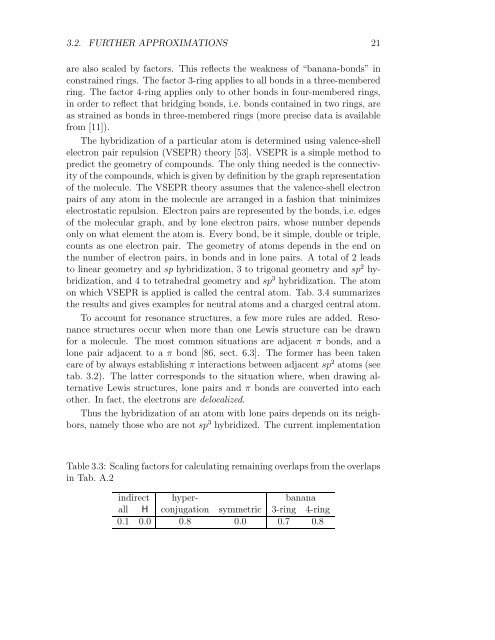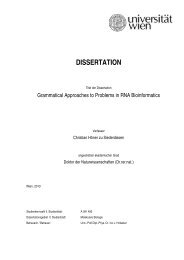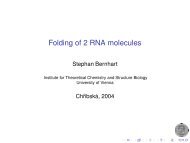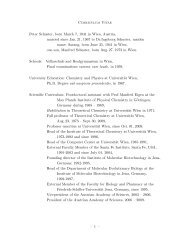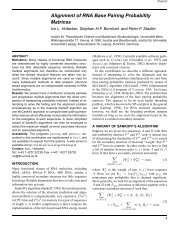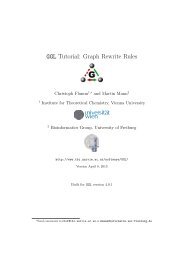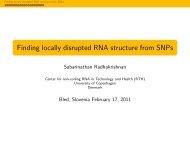A Toy Model of Chemical Reaction Networks - TBI - Universität Wien
A Toy Model of Chemical Reaction Networks - TBI - Universität Wien
A Toy Model of Chemical Reaction Networks - TBI - Universität Wien
Create successful ePaper yourself
Turn your PDF publications into a flip-book with our unique Google optimized e-Paper software.
3.2. FURTHER APPROXIMATIONS 21<br />
are also scaled by factors. This reflects the weakness <strong>of</strong> “banana-bonds” in<br />
constrained rings. The factor 3-ring applies to all bonds in a three-membered<br />
ring. The factor 4-ring applies only to other bonds in four-membered rings,<br />
in order to reflect that bridging bonds, i.e. bonds contained in two rings, are<br />
as strained as bonds in three-membered rings (more precise data is available<br />
from [11]).<br />
The hybridization <strong>of</strong> a particular atom is determined using valence-shell<br />
electron pair repulsion (VSEPR) theory [53]. VSEPR is a simple method to<br />
predict the geometry <strong>of</strong> compounds. The only thing needed is the connectivity<br />
<strong>of</strong> the compounds, which is given by definition by the graph representation<br />
<strong>of</strong> the molecule. The VSEPR theory assumes that the valence-shell electron<br />
pairs <strong>of</strong> any atom in the molecule are arranged in a fashion that minimizes<br />
electrostatic repulsion. Electron pairs are represented by the bonds, i.e. edges<br />
<strong>of</strong> the molecular graph, and by lone electron pairs, whose number depends<br />
only on what element the atom is. Every bond, be it simple, double or triple,<br />
counts as one electron pair. The geometry <strong>of</strong> atoms depends in the end on<br />
the number <strong>of</strong> electron pairs, in bonds and in lone pairs. A total <strong>of</strong> 2 leads<br />
to linear geometry and sp hybridization, 3 to trigonal geometry and sp 2 hybridization,<br />
and 4 to tetrahedral geometry and sp 3 hybridization. The atom<br />
on which VSEPR is applied is called the central atom. Tab. 3.4 summarizes<br />
the results and gives examples for neutral atoms and a charged central atom.<br />
To account for resonance structures, a few more rules are added. Resonance<br />
structures occur when more than one Lewis structure can be drawn<br />
for a molecule. The most common situations are adjacent π bonds, and a<br />
lone pair adjacent to a π bond [86, sect. 6.3]. The former has been taken<br />
care <strong>of</strong> by always establishing π interactions between adjacent sp 2 atoms (see<br />
tab. 3.2). The latter corresponds to the situation where, when drawing alternative<br />
Lewis structures, lone pairs and π bonds are converted into each<br />
other. In fact, the electrons are delocalized.<br />
Thus the hybridization <strong>of</strong> an atom with lone pairs depends on its neighbors,<br />
namely those who are not sp 3 hybridized. The current implementation<br />
Table 3.3: Scaling factors for calculating remaining overlaps from the overlaps<br />
in Tab. A.2<br />
indirect hyper- banana<br />
all H conjugation symmetric 3-ring 4-ring<br />
0.1 0.0 0.8 0.0 0.7 0.8


